What is an NDA?
A Non-Disclosure Agreement (NDA) is a legally binding contract that establishes a confidential relationship between parties. NDAs are essential in protecting sensitive information, ensuring that parties involved in business negotiations, partnerships, or employment relationships do not disclose proprietary information to unauthorized third parties.
Managing NDAs has been a manual, time-consuming process that involves printing, signing, scanning, and emailing documents back and forth. However, with the advent of advanced document generation and electronic signature technologies, this process can be automated and streamlined. In this blog post, we will explore how to automate NDA eSignatures using DocuGenerate and SignRequest, an electronic signature solution designed to make signing documents easy, fast, secure and legally binding.
Key Elements of an NDA
-
Definition of Confidential Information: Clearly specifies what constitutes confidential information. This includes trade secrets, business plans, financial records, customer lists, proprietary technology, and other sensitive data that is not publicly known. It should cover all forms of information, such as written documents, electronic files, and verbal communications.
-
Obligations of the Receiving Party: Outlines the responsibilities of the party receiving the confidential information. This includes using the information only for the purposes specified in the NDA, limiting access to authorized individuals, and taking reasonable steps to protect the information from unauthorized access or disclosure. Security measures like encryption and secure storage may be specified.
-
Exclusions from Confidential Information: Defines what information is not considered confidential. Common exclusions include information that is publicly known, already known to the receiving party, independently developed by the receiving party, or disclosed by a third party without confidentiality obligations.
-
Term of the Agreement: Indicates the duration for which the confidentiality obligations apply. This can vary but is often specified as a fixed period, such as one to five years, or may continue indefinitely until the confidential information no longer qualifies as such.
-
Consequences of Breach: Specifies the penalties for violating the terms of the NDA. This can include legal actions, monetary damages, and injunctions to prevent further disclosure. Clearly outlining the consequences helps deter breaches and provides a clear course of action if a breach occurs.
The Benefits of Automating NDA eSignatures
Handling NDAs manually can be cumbersome and prone to errors. The traditional process involves several steps: drafting the NDA, printing and signing it, scanning and sending it, and then storing the document. This manual process is not only time-consuming but also increases the risk of errors, such as missing signatures or lost documents.
Automating the NDA process with eSignature technology offers numerous benefits. First and foremost, it saves time by reducing the steps required to generate, sign, and store NDAs. Automation also minimizes errors, ensuring that all necessary fields are completed and signatures are obtained. This improved efficiency allows your team to focus on more strategic tasks. Additionally, electronic signatures provide a secure and tamper-evident way to sign documents, enhancing overall security. Finally, reducing the need for paper documents supports eco-friendly business practices.
Creating the NDA Template in DocuGenerate
For the purpose of this tutorial, we’ll be using the NDA Template from theTemplate Library. This template includes all the necessary sections and placeholders for dynamic information, ensuring each generated NDA is complete and accurate.
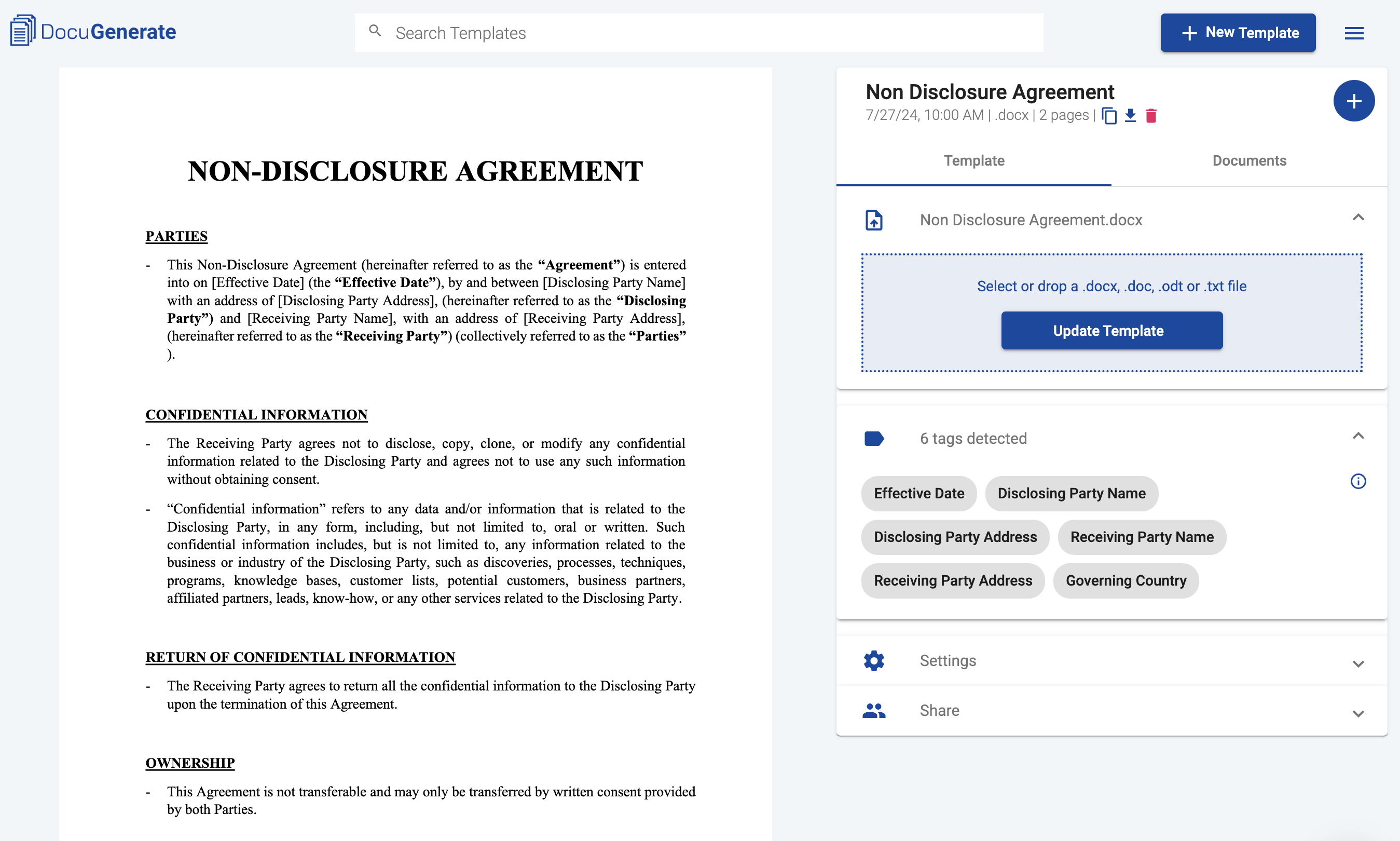
Integrating DocuGenerate with SignRequest via Zapier
To automate the NDA signing process, we’ll use Zapier, a no-code automation tool that will allow us to integrate DocuGenerate with SignRequest seamlessly. Its Zapier app offers flexibility in sending documents for eSignature, which makes it a great fit for our use case. While other eSignature apps require creating a template and generating a document based on that template, SignRequest allows to specify the document to be signed as a URL, which is very convenient.
This integration automates the entire NDA signing process without needing to write any code. We’ll set up a Zap with the following steps:
1. New Document (Trigger)
The workflow begins with the New Document trigger in DocuGenerate, which activates whenever a new document is generated from the NDA template. This ensures the process starts as soon as the NDA is ready.
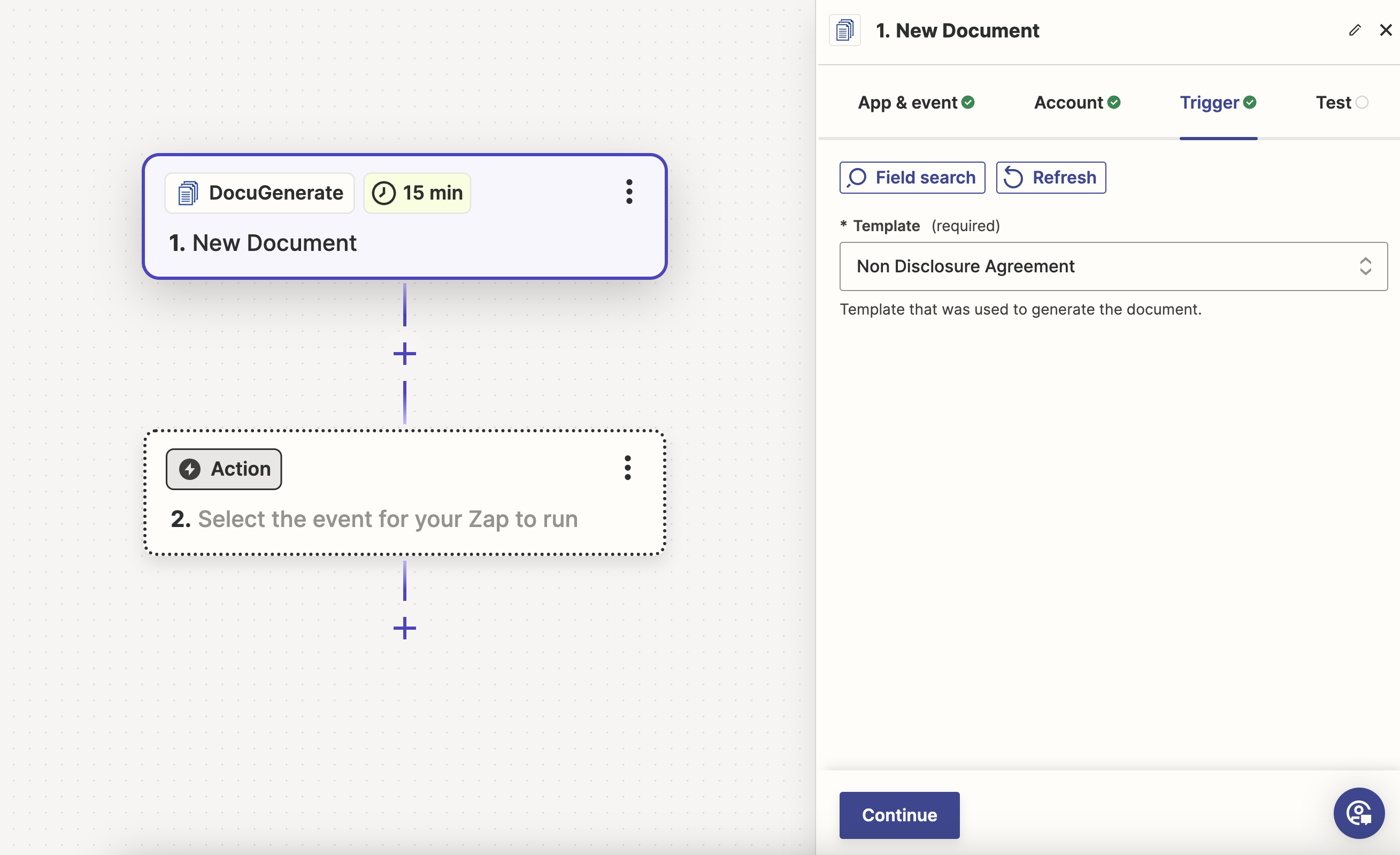
While this tutorial focuses on a simple workflow, you can enhance it further by adding steps to fetch form responses, generate the document, and send the sign request within the same flow. Instead of using the New Document trigger in DocuGenerate, you could use the Generate Document action for a more integrated automation.
2. Text Formatter (Action)
Since we’re simplifying the workflow by skipping the initial form submission and document generation steps, we need a way to get the email address of the NDA recipient. One method is to include the email address in the document name, such as “NDA - john.smith@gmail.com”. The Text Formatter action by Zapier can then extract the email address from the document name by removing the “NDA - “ part. We can name this action Extract email address for example:
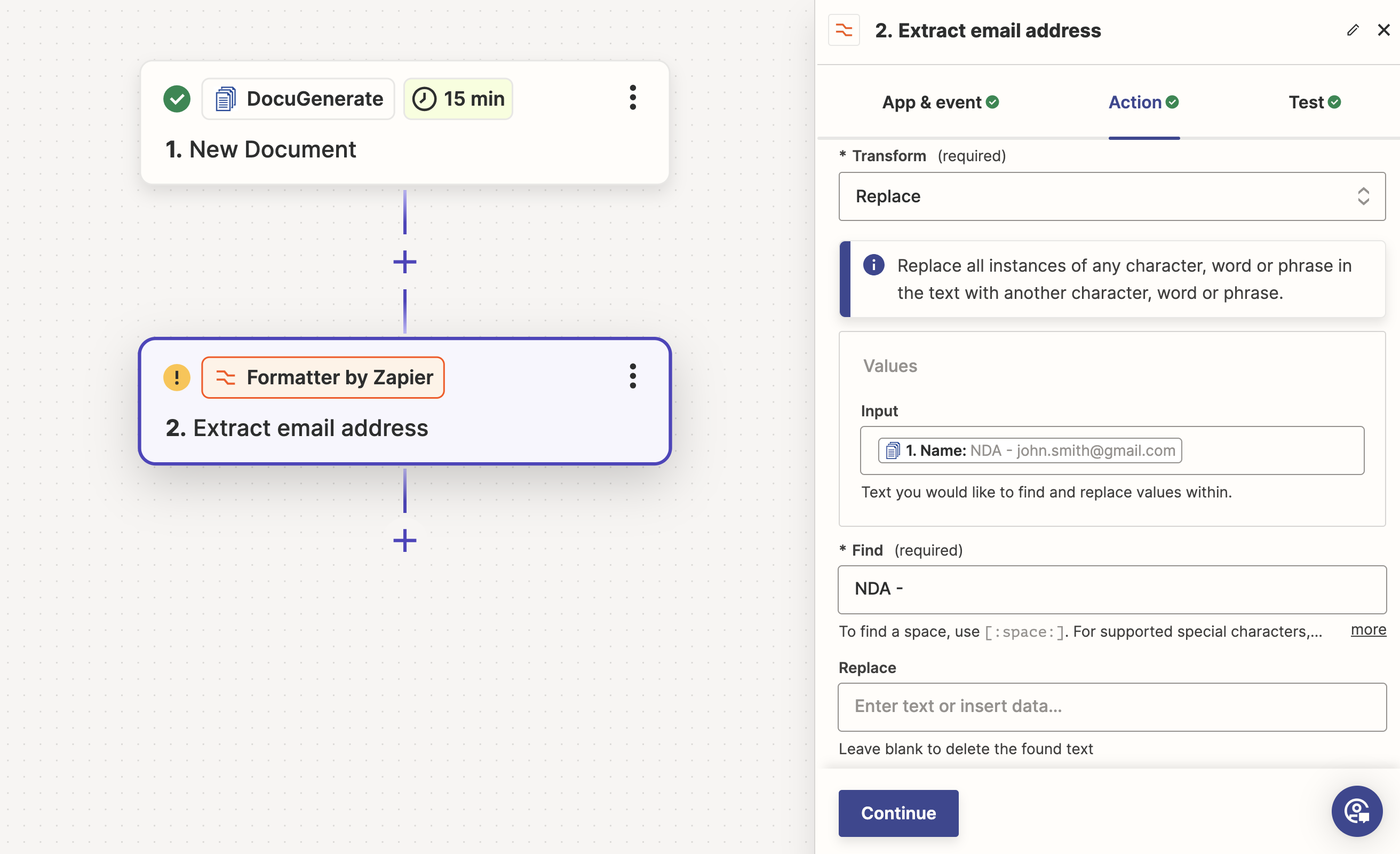
3. Send SignRequest (Action)
Use the Send SignRequest action in SignRequest to send the NDA for eSignature. Set up the parameters as follows:
File From URL receives the Document URL from DocuGenerate.SignRequest Name receives the File Name from DocuGenerate.Signer Email receives the Output from the Text Formatter.
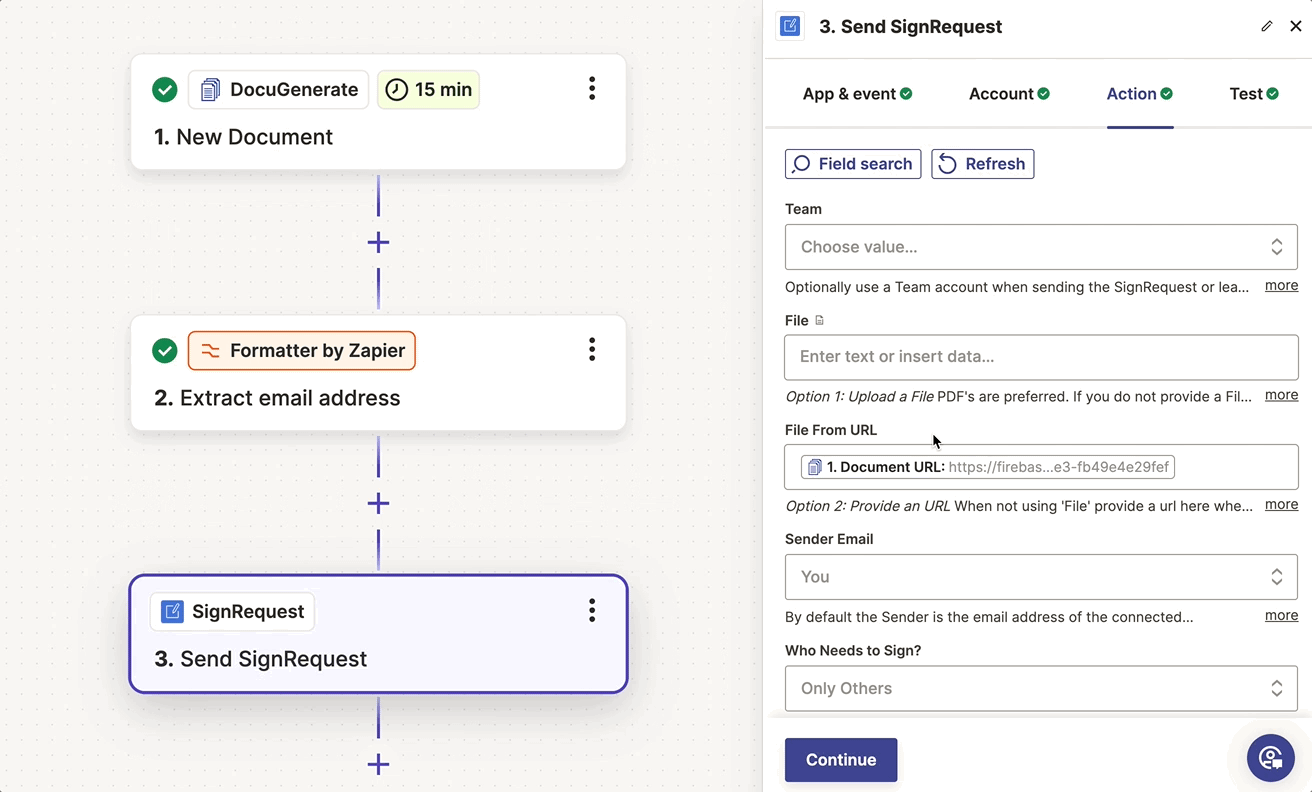
This setup ensures that as soon as an NDA is generated, it is automatically sent for eSignature, streamlining the process and reducing manual intervention.
Email and Signing Process
Once the workflow is activated, the recipient will receive an email with the NDA ready for eSignature. Let’s walk through how the document appears on the SignRequest dashboard, the email received by the recipient, and the signing process itself.
1. SignRequest Dashboard View
After the document is generated and sent for signature, it will appear on your SignRequest dashboard . Here, you can easily track the status of all your documents, see who has signed, and who still needs to sign. This dashboard provides a centralized view, making it easy to manage all your signed documents.
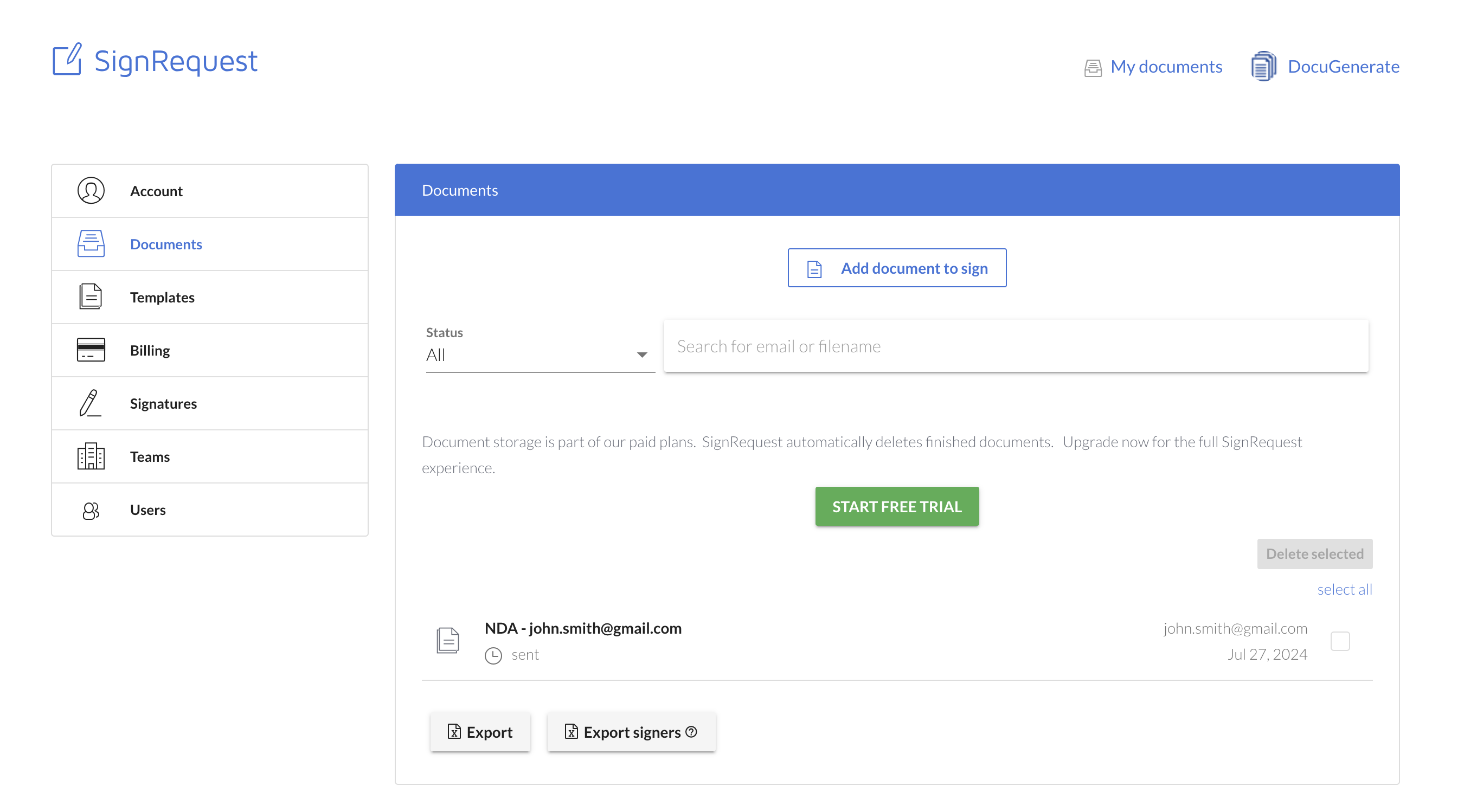
2. Recipient Email Notification
The recipient will receive an email notification from SignRequest, informing them that they have a document waiting for their signature. This email includes a secure link to the document, ensuring that only the intended recipient can access and sign the NDA.
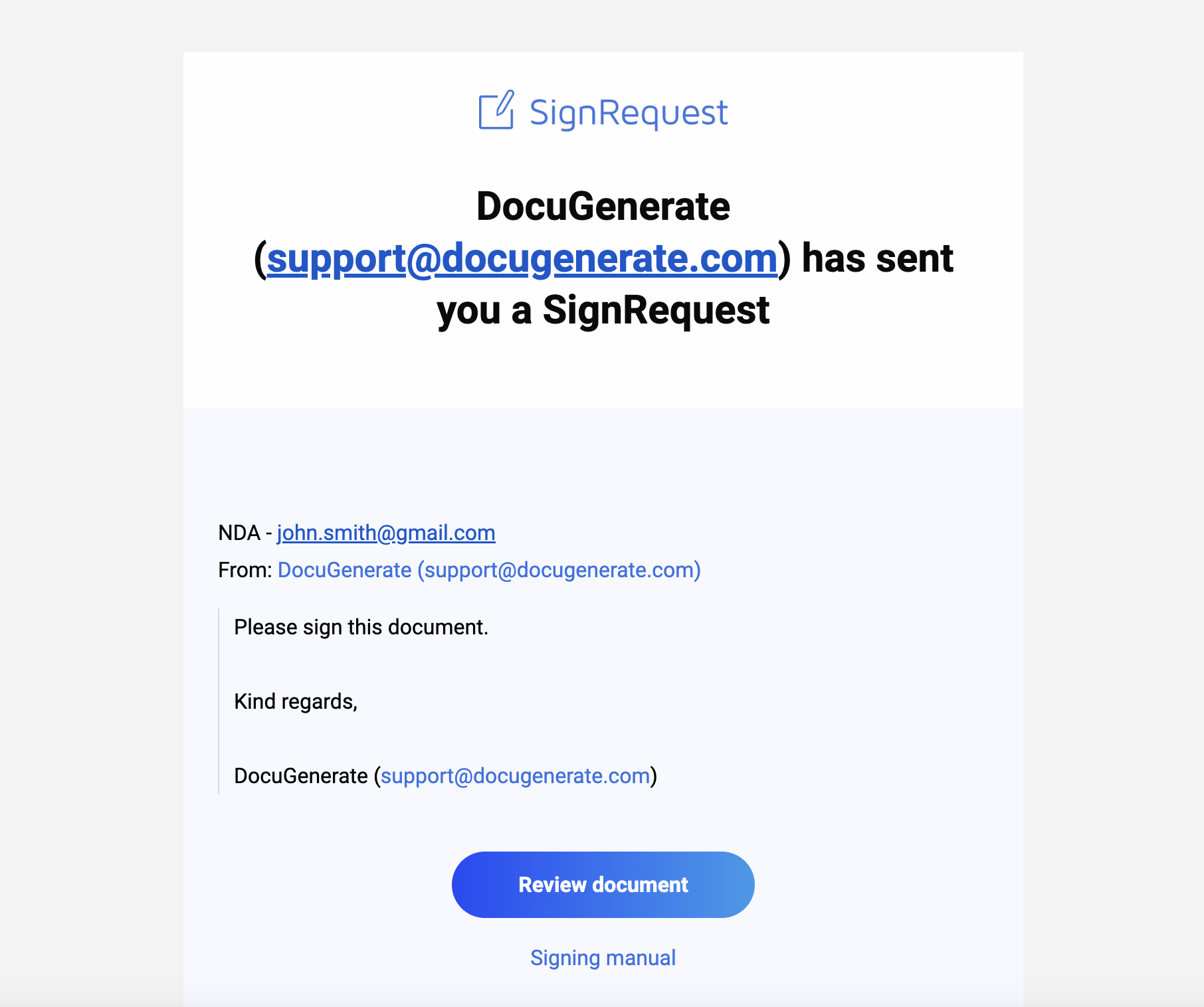
3. Signing Process
Clicking the link in the email will take the recipient to the SignRequest platform, where they can review and sign the NDA. The signing process is intuitive and straightforward, requiring only a few clicks. The recipient can sign the document electronically, and once signed, both parties will receive a copy of the signed NDA.

This seamless experience ensures that the NDA is signed quickly and securely, without the need for printing, scanning, or mailing physical documents.
Example Use Cases
Automating NDA generation and eSignatures can be highly beneficial across various scenarios. Here are some examples:
-
Sales Process
In a sales process, before booking a call with a potential client, you might need them to sign an NDA to protect sensitive business information. You can create a form for the client to fill out with basic information needed to populate the NDA. This form submission triggers the generation of the NDA using DocuGenerate, and it is then sent for eSignature via SignRequest. For more detailed instructions on creating such a form, refer to our blog article about Generating Reports based on Form Submission (while that tutorial uses Make instead of Zapier, the principle remains the same).
-
Employee Onboarding
During the onboarding of new employees, companies often require signing an NDA to protect proprietary information. Automating this process ensures that every new hire receives and signs the NDA promptly. New employees can fill out their details through an online form, triggering the generation and sending of the NDA, streamlining the HR workflow and ensuring compliance.
-
Partnership Agreements
When entering into partnerships with other businesses or freelancers, it’s crucial to have an NDA in place to protect shared information. Automating the NDA generation and signing process ensures that these agreements are handled efficiently and securely. Partners can easily sign the NDA electronically, which speeds up the process and reduces administrative overhead.
-
Consultant Engagements
Companies often engage consultants to work on sensitive projects. An NDA is essential to protect intellectual property and confidential data. Automating the NDA process allows companies to quickly generate and send NDAs to consultants, ensuring that all necessary legal protections are in place before any work begins.
-
Mergers and Acquisitions
In mergers and acquisitions, NDAs are critical to protect sensitive financial and strategic information during negotiations. Automating the generation and eSignature process of NDAs ensures that all parties involved can quickly sign and access the necessary agreements, facilitating smoother and faster transactions.
Conclusion
Automating NDA eSignatures with DocuGenerate and SignRequest offers significant benefits, including time savings, error reduction, improved efficiency, enhanced security, and environmental benefits. By following the steps outlined in this guide, you can streamline your NDA workflow, allowing you to focus on more strategic tasks and improve overall productivity.
Incorporating DocuGenerate and SignRequest into your document management process is a smart move for any business looking to modernize its operations and stay ahead in today’s competitive landscape. Start automating your NDA eSignatures today and experience the transformative impact of these powerful tools.
Resources












